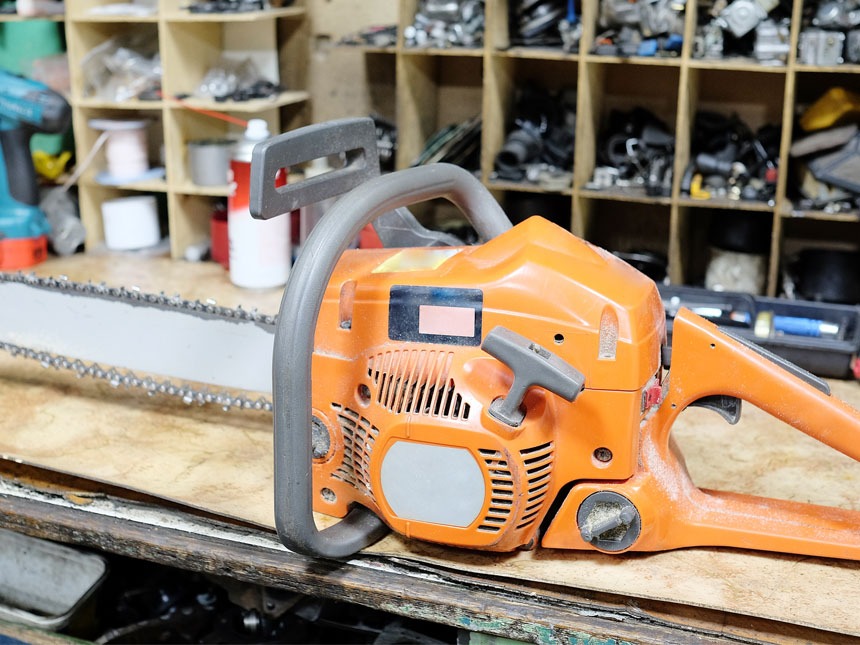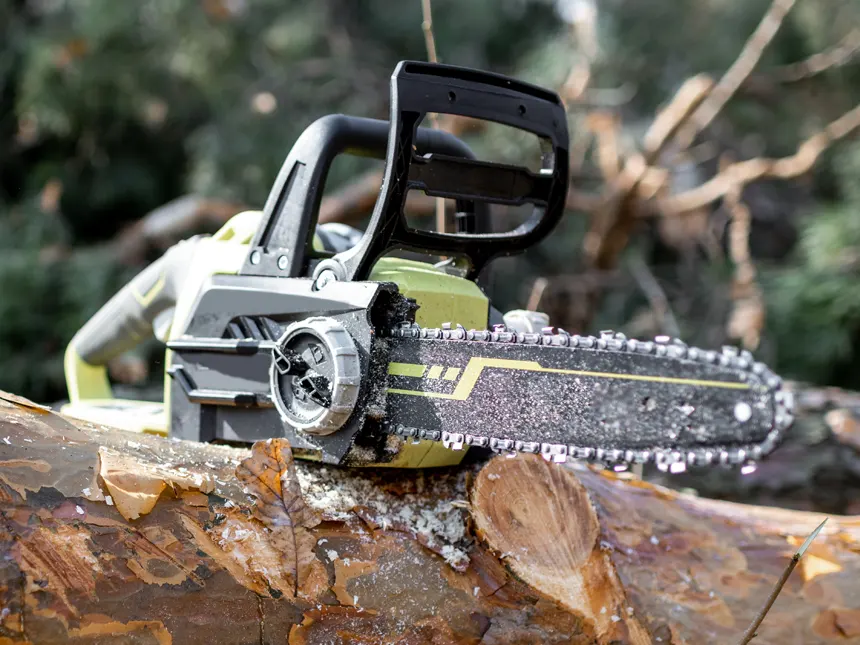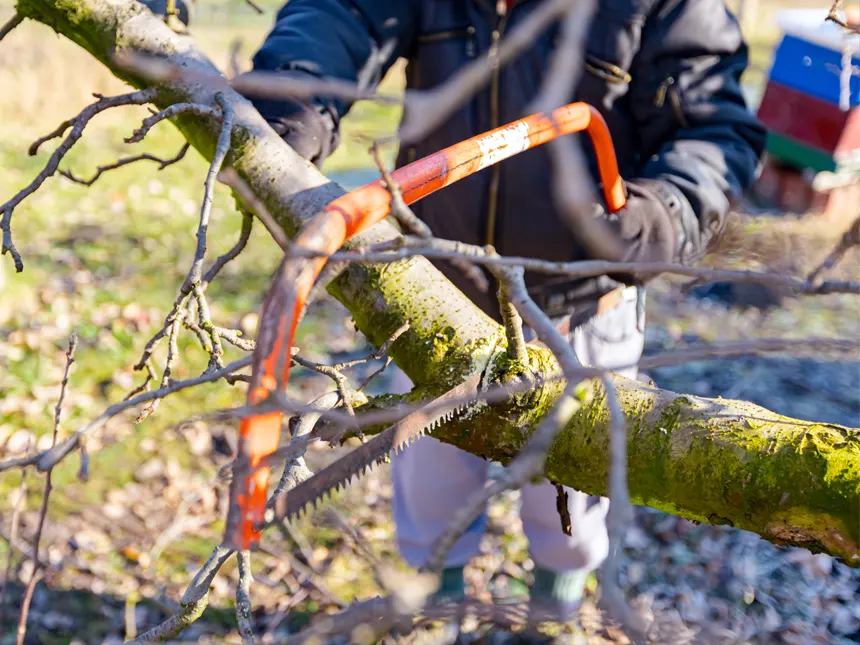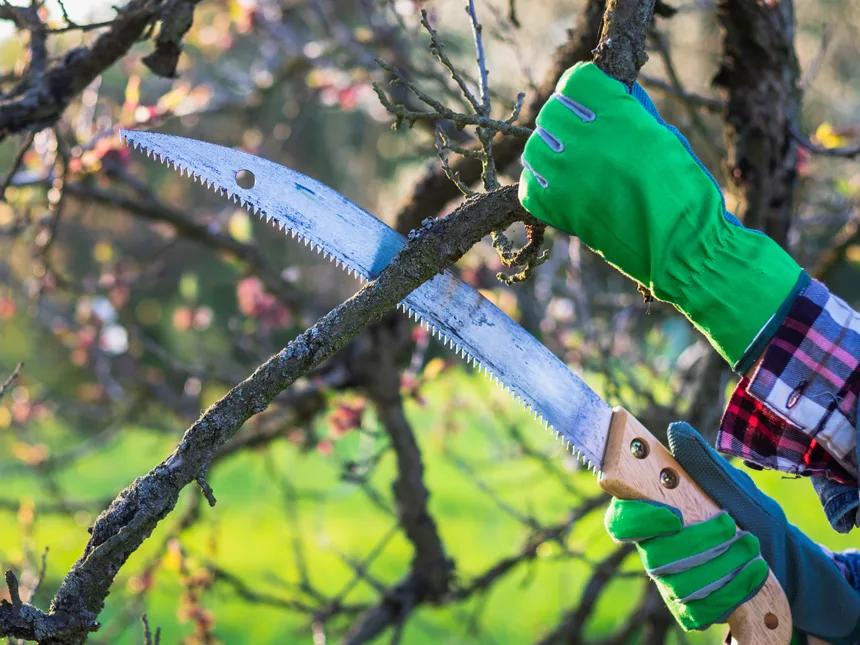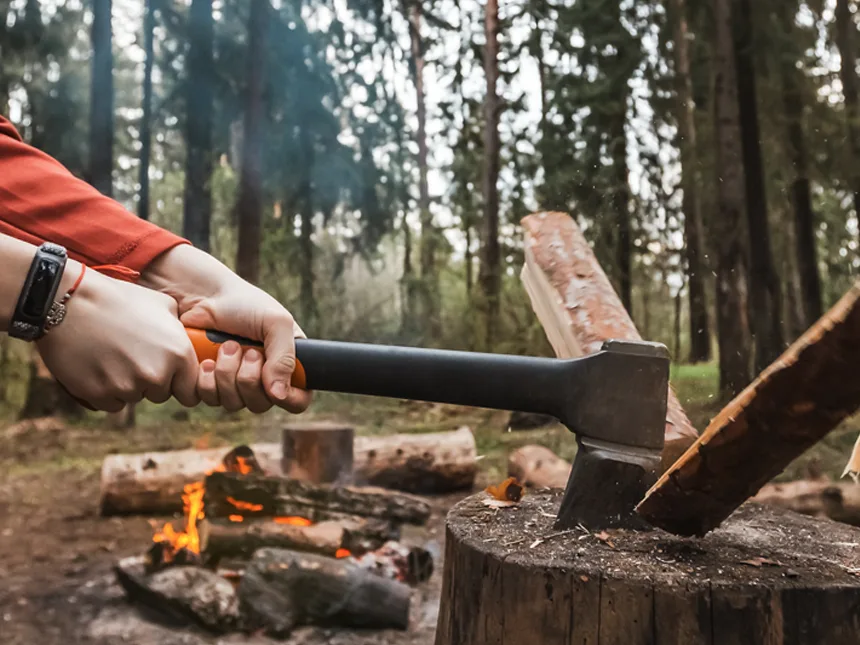Types of Axes
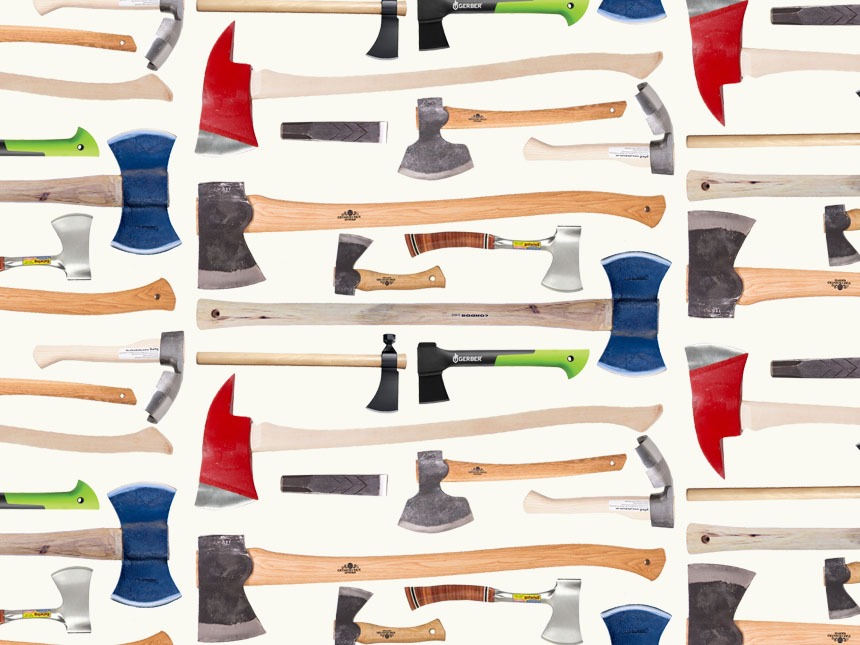
Timber Gadgets is reader-supported. We may earn a commission if you buy through the links on our site.
During the 19th century, a wealth of different types of axes and patterns were established for use in felling timber, splitting logs, shaping lumber, and carpentry. The same is largely true today; each type of axe is meant for a specific task.
In those days, however, axe’s weren’t mass-produced. They were hand forged by local blacksmiths. So the tool you ended up with was unique. Likewise, the type of trees in a local area was unique as well, which affected the shape and weight of the axe. Hardwoods required heavier, more robust axes.
What you were doing made a big difference, too. While using a hatchet to fell a tree, split wood, and hew a log is possible – it’s not practical. That’s because hatchets are small and serve a different purpose.
Each job has a unique tool suited for the purpose of doing each task effectively. This is why there are many different types of axes and head patterns.
Now that you know why there are so many, let’s take a look at what I consider the “main” kinds of axes. Keep in mind, I’m trying to organize and explain to the best of my ability. Not everyone will agree with my methods of categorization but it’s enough information to get you started.
Table of Contents
The “Main” Types of Axes
To classify the main kinds of axes, we should first start by looking at the tasks at hand. Why were these axes (or hatchets) made? Some of the “main” uses of axes can be found in forestry, splitting, and carpentry.
Forestry contains a broad amount of axes and hatchets. A good example of this would be a felling axe; designed for “felling” trees. It could include smaller hand axes or hatchets not meant for felling as well. They’re meant to be used in the woods.
A splitting axe or maul serves one purpose – to split wood. The wood will then be used as firewood. Again, think of this as a broad category that includes splitting mauls which are used for dense, hardwoods and splitting axes that are more manageable to use.
Then there are carpenter’s axes or what I like to call a utility axe. These come in all shapes and sizes and they’re designed for specific tasks like roofing, carving, shaping wood, etc.
Without further delay, let’s take a look at each of these types. Again, remember these are really broad categories, with many sub-categories and speciality items.
Forest Axe
The forest axe contains anything from small hatchets to large felling axes. They’re designed for use in wooded areas. The haft or handle length can vary from 10 to 36 inches in length. The weight of the head fluctuates depending on the intended function as well.
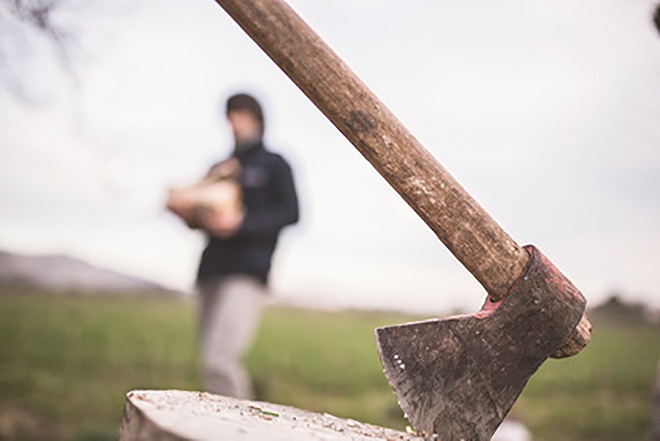
A felling axe is designed with the intention of chopping down trees. They’re swung at an angle which cuts across the grain of the wood. In contrast, splitting axes cut with the grain to split the wood in half.
Similar to a felling axe but shorter in length is the hatchet or hand axe. They serve a multitude of uses, all of which are accomplished by using one hand. After all, that’s what a hatchet is; a small, one-handed axe. They’re used in removing tree limbs, split kindling, felling small trees, and more. A hatchet can be as small as 9.5 inches and stored easily in a rucksack. They’re ideal for transporting while camping, hiking, or in any situation where you don’t have a lot of space or you don’t want to carry a full-sized axe.

I hate to generalize so many axes into one category, but for the sake of simplicity, I am. The shape of the forest axe’s head is often more slender in comparison to that of a splitting axe. Please notice the illustration above.
The thickness of the head is what I’m pointing out. For more comparison, see the other illustration in the splitting axe section below.
Splitting Axe
A splitting axe, as its name implies, is meant to split wood. There are axes, hatchets, and mauls designed for splitting firewood.
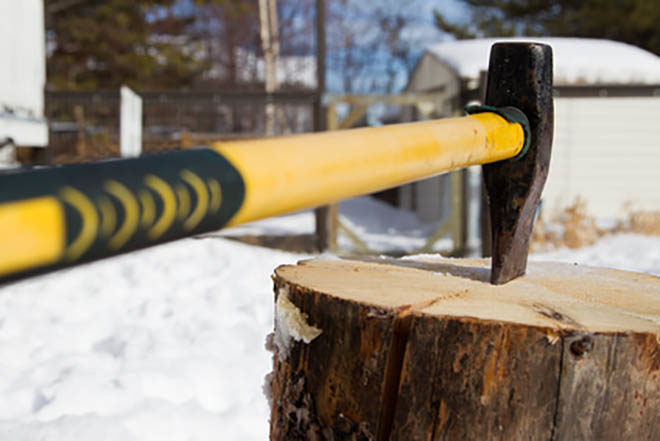
Their head is heavy and shaped differently than other axes, with a thick “V” shape. Weighing anywhere between a few pounds up to 7 and 9 lbs, they can be hard to handle. While you may think the bigger, heavier option is best suited for the job, you should stop and ask yourself “Do I really want to swing this thing over and over again?”
A 9 lb splitting maul will make short work of hardwood but if you don’t need it, I recommend using a lighter splitting axe; something around 5 lbs. They’re easier to swing and do a great job splitting firewood.

When comparing the head of the splitting axe to other types, you can clearly notice a much bigger, bulky shape. This design is very intentional. The more aggressive angle splits and pushes apart the wood you’re cutting.
Carpenter’s Axe
Also known as “log-building” axes, a carpenter’s axe isn’t easily classified in such a broad category. These tools are used in for hewing, carving wood, roofing, and more. They’re what I consider a very specialized axe; meant for 1 purpose.
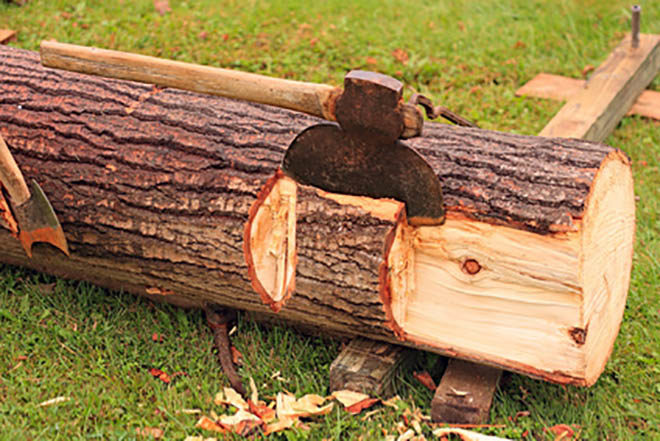
A broad axe sports a long beard and tilted handle. They’re used in hewing, which involves shaping lumber into wooden beams. It’s not a common practice in modern construction but it’s a process still used today.
Another popular tool is the adze, which is commonly used along the top surface of a log. Their purpose is to shave and shape a piece of lumber into a nice beam or post.
Modern carpenter’s axes have a hammer poll as well as a groove somewhere along with the beard of the head, meant for pulling nails. Carpenter’s axes are mostly small, one-handed tools but not always.
The Head of the Axe
The head is the business end; the sharp, cutting portion of the axe. And, as you can imagine, there are different kinds. Mainly in terms of the bit and pole. Now, if don’t know what the bit or poll is, I suggest learning the parts of an axe.
In short, the bit is the sharp, cutting edge and the poll is back of the head. In this section, we will explore a few variations.
Single and Double-bit Axes
You’ve probably seen both a single and double-bit axe before, whether you know it or not. A single-bit has one cutting edge while a double-bit has two.
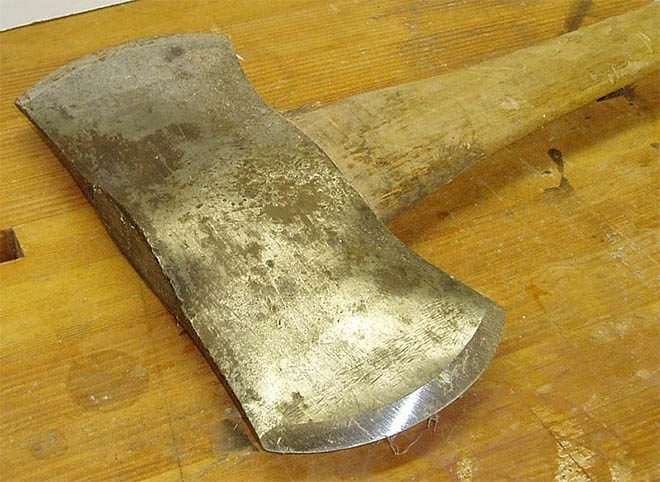
On a single-bit axe, there is a cutting edge on one side and a poll on the other. Up until this point, most of what we’ve discussed have been single-bits. The double-bit, however, does away with the poll and adds another cutting edge.
While having two blades on an axe has loads of benefits, the main purpose of its creation is really simple. Woodsmen could essentially carry in one axe instead of two.
One bit is used to break the bark of the tree while the other is used for chopping. A tree’s bark often hides a lot of dirt, which dulls a blade rather quickly. So having one side dedicated to de-barking was a major benefit.
That’s just one example. To sum it up, having two bits is better than one (in some cases). When one edge becomes dull, flip the axe and use the other bit.
The Steel
You can’t talk about the different types of axes without addressing steel. Among the most popular combinations are carbon steel, stainless steel 400, and stainless steel AUS 6. The hardness of the blade, in terms of the Rockwell hardness scale, is determined by the type of steel and how sharp you can possibly make it. How long the edge holds, how it resists corrosion, and other factors all play a part in the quality of the tool.
Carbon Steel is a popular choice because it’s strong, maintains an edge for a decent amount of time, and resists some corrosion. While all steel contains some carbon in it, carbon steel is primarily just that; carbon and steel. It has very little else in it.
The most important ingredient in steel is carbon. It’s responsible for the hardening of the steel. Too much carbon, however, can reduce its longevity, making it brittle and easy to break.
A naming system created by SAE classified the amount of carbon within the steel with a number series “10??”. A medium-level of carbon is around 0.5%, which is SAE 1050 steel.
You’ve probably seen this classification system before when marked on a carbon-steel product. Carbon steel 1050 is medium while anything about 1070 is considered hard.
Stainless Steel is another popular steel used for axes. In order to be considered stainless steel, there needs to be at least 12% chromium present. The element chromium is excellent at resisting corrosion, hence the reason it’s named “stainless steel”. Unfortunately, stainless steel is a softer metal. It can be hardened with other elements to increase its longevity and usefulness, but in general, it’s a cheap metal.
You’ve likely heard of “420 stainless steel” before, probably in a commercial or printed on the label of a steel product you purchased. Compared to high-carbon steel, 420 stainless is fairly soft. You can, however, get harder stainless steel in the form of 440.
AUS-6, also known as 6 A, is another stainless steel product. It’s comparable to 420 stainless. It has around 0.65% carbon, which isn’t terrible. There is, on the other hand, an AUS-8 and AUS-10, which have 0.75% to 1.1% carbon.
The Poll
The poll is perhaps the 2nd most utilized part of an axe. It’s the perfect place to add another tool to an already useful device. The poll is the back part, opposite from the cutting edge. In some cases, this isn’t designed for use in any way but in other cases, it can be used as a wedge, hammer, pick, and even a smoking pipe, believe it or not.
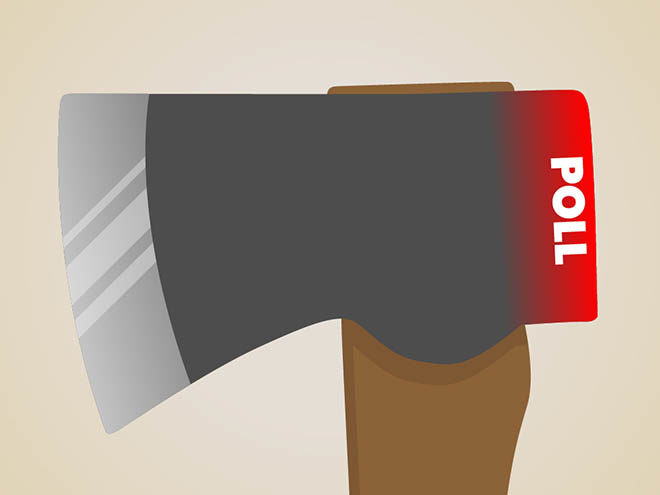
- A fireman’s axe is the first type that comes to mind in describing the poll end. On one side you have the bit which a fireman uses to chop or cut basically anything in his or her way; walls, ceilings, etc. On the opposite end is the pick or “pick blade” which is used for prying and cutting as well.
- Another great example is a shingling hatchet. One end has a bit and the other end is equipped with a hammer. As you can imagine, it doesn’t take much to come with a handful of different tools which fit nicely on the poll of an axe.
- Most people have heard of a tomahawk. What most people don’t know, however, is that traditional Native American tomahawks have is a smoking pipe on the poll. Yes, that’s right, a smoking pipe. Not only can you chop wood but, when you need a break, you can load tobacco in the poll and smoke from the handle!
Not all polls are created equal. Some are meant to take a pounding but most aren’t. In fact, a lot of axes have a soft metal head aside from the bit. For that reason, I don’t recommend hitting the poll with another hammer unless you know for certain it’s designed to be used in such a way.
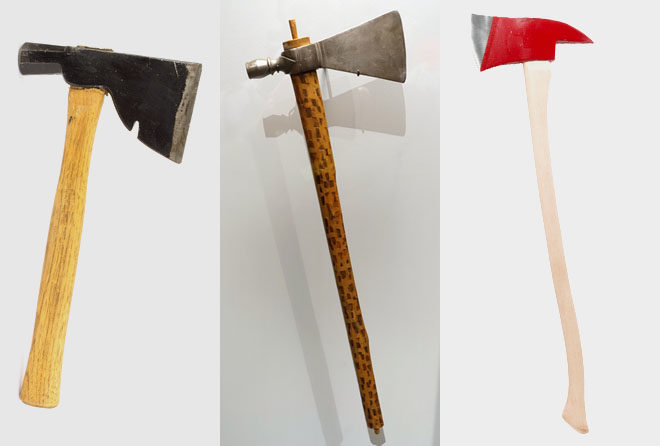
Head Patterns
A head pattern is a model for a certain type of axe. It can have a different shape while doing the same job. This is especially apparent when comparing older axes and those forged in different regions of the world.
For example, the Jersey head pattern is broader than a North Carolina head pattern. Both of which have steep corners. In contrast to these patterns, a Michigan pattern is more rounded but roughly the same size as the Kentucky pattern. See the illustration below for more information.
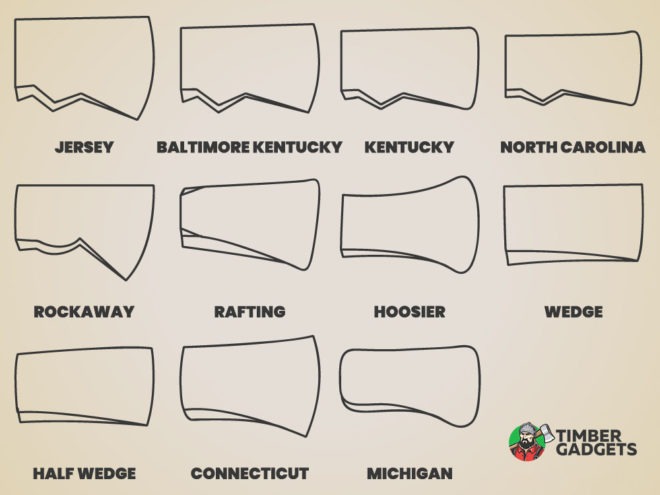
As you can see, there are quite a few patterns. This doesn’t even scratch the surface. There are at least 17 different single-bit head patterns and 11 double-bit head patterns.
One of the most distinguishable features of the different patterns is the lug. The lug is the “V” shaped portion of the head which comes into contact with the handle. The lug is most apparent when comparing Jersey, Kentucky, and North Carolina patterns to the Michigan pattern. In comparison, the Rockaway pattern has a rounded lug.
The Length of the Haft
Another category you can divide axes into is by the length of their haft, or handle. Shorter axes are great for carrying in the wood, camping, etc but they aren’t nearly as useful in felling a tree as something with a 32″ handle. Likewise, a large handle is cumbersome for hiking or ‘limbing’ a small tree outback.
Small
An axe with a haft between 10 – 16 inches in length is what most consider a hatchet. The head will be smaller as well, but in terms of the handle it comes down to this; a hatchet is a one-handed tool. The overall weight is light, making them great for carrying. They’re fantastic for camping, hiking, etc.
Medium
A medium-sized axe, in my opinion, is a great all-around tool. They range in sizes from 18 – 26 inches in length. They’re no longer what I consider to be a hatchet because there is plenty of space for two hands. Weighing more and taking up more space, not everyone is willing to pack one of these along for a hike.
A medium-sized axe is a great fit for a farm, homestead, or cabin. You don’t need to be a giant to wield one and you can easily fell a tree with one. They’re great for splitting wood, removing tree limbs, splitting kindling, and more.
Large
Anything over 28 inches is typically considered a large axe. The most common size for a large splitting axe is 32″. Even larger hafts can be up to 36 inches in length and they’re found on many of the heavy splitting mauls nowadays.
The greater the length of the axe, the more force you’re able to generate when delivering a blow. Don’t overdo this, though. A few inches won’t make a huge difference in your wood chopping ability. What’s more important is your safety and how comfortable you feel while swinging it.
How to Choose an Axe
Choosing a good axe can be a difficult task, especially if you’re unfamiliar with the subject, to begin with. By this point though, you should have a good understanding of the basics. Now that you know about some of the different types of axes, it’s important to hone in on the important stuff; what you need it for, the length of the handle, and the overall weight.
Size & Weight
Yes, I’m sure you can swing the 9 lb, 36-inch splitting maul but… do you really want to? After all, if you’re not splitting a sweet gum or knotted elm, you probably don’t need a super heavy splitting maul.
I recommend finding something suitable for your body size. There is nothing wrong with a 5 – 7 lb splitting maul. It will suffice for splitting most types of wood. Likewise on the length. Only buy an axe you feel comfortable swinging.
Quality & Price
Not only is the size and weight important, but the quality is also. Nowadays, most axes at the local hardware store are what I consider a “throwaway axe”. They are machine-made with weak steel and composite handles.
You can’t easily replace a composite handle. These types of axes will last you a few years and, for the price, they’re a great fit and worth the money. On the other hand, they’re not what I consider high-quality.
I don’t recommend these brands unless you’re just looking for a cheap axe to use every once in a while. You can find cheap hatchets for around $25 and large splitting mauls for $40 – $50. Here are a few of the cheaper brands.
- Fiskars
- Mintcraft
- Tabor Tools
- Estwing
Getting a quality, hand-forged axe from one of the most renowned brands in the world will last you a lifetime. Should you break or wear out the handle, you can replace it. The steel is stronger and holds an edge better.
Nearly all the imperfections are gone. As you can imagine, they cost more but if you can afford it, you won’t be disappointed. For the top tier, you will pay over $100 for a hatchet and $200 or more for something larger. Some of these brands are listed below.
- Gransfors Bruk
- Wetterlings
- Hults Bruk
- Prandi
There are a few mid-tier brands as well; they offer reasonable quality at a fair price. The one I’m most impressed with is Husqvarna. Now, they sell composite handle axes but they’re not the ones I’m excited about. Husqvarna offers mid-tier, wooden-handle axes which are an amazing deal.
From what I understand, they purchase hand-forged heads from other manufacturers, use a cheaper wooden handle, place their logo on them, and sell them at a very reasonable price. You will likely spend $70 – $80 on a hatchet and more for a large axe or splitting maul. Another mid-tier brand is Council Tool, which have similar quality products.

